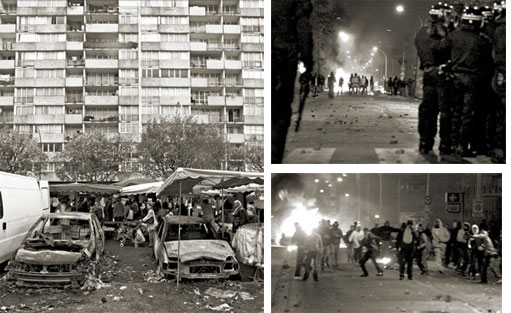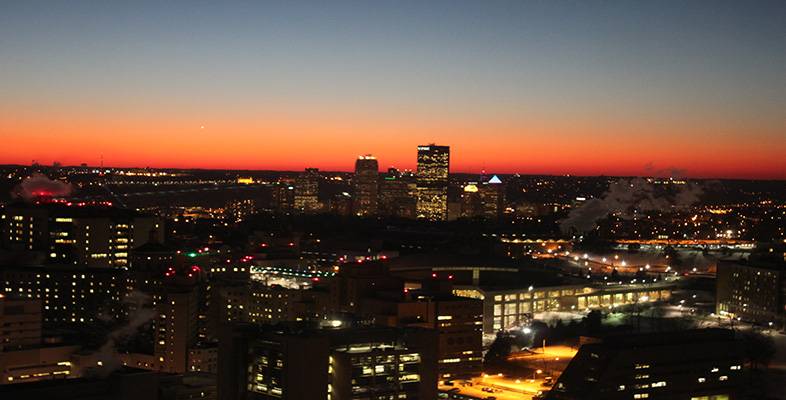3.2 Urban unrest: the case of the French urban periphery
‘France had a rebellion of its underclass’, argued American social scientist Immanuel Wallerstein (2005). He was referring to the ‘unrest’ or ‘riots’ which began on Thursday 28 October 2005 in Clichy-sous-Bois, a large public housing estate, or banlieue, on the outskirts of Paris, and then spread to a number of other areas across urban France. The riots were sparked by the accidental deaths of two young boys fleeing the police. The boys were subsequently referred to by the then Interior Minister (and later French President) Nicolas Sarkozy as ‘delinquent scum’ (quoted in Ossman and Terrio, 2006, p. 6). Nearly 300 neighbourhoods across France were affected by the ensuing unrest; within the space of three weeks, around 10,000 vehicles had been destroyed and almost £200m damage done to property. Sarkozy's response was to declare a state of emergency and demand a series of severe penal sanctions against those involved in the unrest. Such a response was symptomatic of deep-seated antipathy towards, and growing fear of, the criminality and disorder associated with places such as Clichy-sous-Bois experienced by some sections of French society. But his subsequent order in November that all ‘foreigners’ found guilty of rioting were to be deported, whether they were in France legally or not, not only fuelled further resentment but also highlighted many of the underlying tensions in French society.
The term banlieue does not translate easily into English. Banlieues are generally suburban districts around the major French cities, but they do not equate with suburbs as the term is generally used in the UK. As French Marxist philosopher Etienne Balibar notes:
There are banlieues and banlieues, often geographically very close to one another but separated by a social abyss and a permanent antagonism …: some are rich, even very rich …; others are symbols of poverty, the decline of public services, the relegation of ethnic minorities and poor whites, unemployment and stigmatization … In many respects, even if the riots extended to other urban areas (especially outside Paris), it was this clash within the banlieue, between the two worlds it contains, that was characteristic…. the banlieue … is a frontier, a border-area and a frontline.
(Balibar, 2007, p. 48)
The worlds that Balibar highlights are shaped by patterns of migration, France's colonial past and present, and its class structure. According to one commentator, a line is increasingly drawn in French society ‘between the Français-de-souche (white-Catholic-French) and those of color, primarily “new” immigrants from North and sub-Saharan Africa’ (Orlando, 2003, p. 395), many of whom are Muslim, impoverished and live in banlieue neighbourhoods. Large-scale development of the banlieue began in the 1960s, resettling both working-class populations moving from inner-city areas and migrants arriving from various French colonies. The construction of what were often high-rise, public-sector housing estates accompanied the relocation of manufacturing industries and the expansion of new industrial areas in the suburbs. As in the UK, such estates reflected political and policymaking concerns to provide better housing predominantly for the white working-class population but in the process also created new patterns of social segregation.

By the 1990s, the banlieue had become a byword for a range of social ills: industrial decline; rising poverty; urban decay; high unemployment; declining public services; and a rapidly deteriorating physical environment. Increasingly used to house black and Arab populations, the French mainstream media and political elites also associated them with poverty, criminality and social decay. They were a world removed from ‘traditional’ (i.e. white Catholic) French society, a world in which social tensions between disaffected youth and the police regularly spilled over into unrest. For some commentators, as well as for many residents in the banlieue, the unrest in late 2005 was a rebellion against police harassment, poverty and the racism of French society. For Wallerstein (2005) it also reflects the growing social polarisation accompanying the steady urbanisation of the world's population. Ossman and Terrio (2006) also draw out the wider global processes that are at work here, commenting:
If the French riots of 2005 so dominated international news, it is not simply due to Americans' desire to punish the French for their position on Iraq, or plays of one upmanship on the part of the British. It is that they are an occasion to explore a reconceptualization of the spaces of danger, culture, territory, and sovereignty that is taking place. Since the 1980s car burnings, supermarket lootings, and destruction of police stations in projects outside Paris, Lyon, and Strasbourg have been discussed not only as a time bomb ticking in the suburbs, but as an intifada [uprising] of the suburbs perpetrated by ghetto hoodlums. … [I]t is only too apparent that the backdrop for such discussions of the events in France was an image of a vague, transnational suburban zone that each national government is engaged with containing and controlling on its own territory.
(Ossman and Terrio, 2006, p. 14)
Here, the global echoes of unrest in France can be seen in the ways that it brings together issues around war, migration, security and injustice (see also Cochrane and Talbot, 2008b). In the early twenty-first century, such issues take on a renewed vigour amidst the rising levels of inequality and the growing tensions between the global rich and poor, not only played out in developing countries but also in the centres of global capitalism, such as in the UK, France and the USA. And the use of the term ‘intifada’, while pointing to specific Palestinian revolts against Israeli occupation, also speaks to the increasing perception in the Judaeo-Christian West of the ‘threat’ posed by Islam.
Our brief journey around the events in France in late 2005 suggests many issues about the identification of disadvantaged groups as problem populations. From the example of the banlieue we can also see that, over time, particular places come to accommodate populations, such as working-class slum-dwellers or other marginalised populations such as immigrants, which are seen as being vulnerable and in need in some way. This is the reconceptualisation of problem people and problem places to which Ossman and Terrio (2006) refer in their reflection on continuity and change in the construction of particular locales as dangerous places of social decay and violence.
Activity 3
Reflect on the case studies of New Orleans (Section 2) and the banlieue in this section.
How do wider social inequalities and social divisions shape the experiences of the populations in these localities?
What would you identify as the shared themes that emerge in these case studies?
Discussion
As in New Orleans, ‘race’ and class come together in the French urban periphery in particular ways. The marginalised populations in each are the product of migrations which, though reflecting different colonial pasts, share a present as the internally excluded in their respective national contexts. Both populations are seen as dangerous yet vulnerable due to high rates of unemployment, poor housing and entrenched economic insecurity. There are also common themes about the failures of state welfare and the social impacts of reductions in welfare spending. Issues of crime and disorder are also brought into focus: we can see how such issues came to be the dominant concerns of governments and local agencies. In both contexts, sections of the mainstream media and politicians mobilised pre-existing racist antipathies to reproduce stereotypes of the populations of both locales as criminal and disorderly. Against this, the marginalised populations of the French banlieue and New Orleans struggle to draw attention to issues of poverty, racism, the erosion of welfare, and police hostility – in other words, to a range of social harms and crimes of the state. The hurricane in New Orleans and oppressive policing in the banlieue were merely the sparks that reignited the fires of social injustice.
